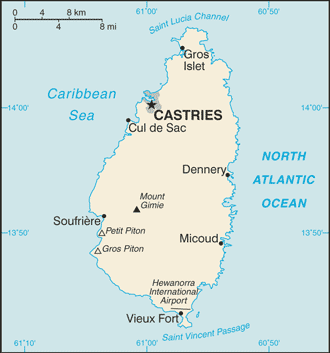|
Saint Lucia
|

|
Capital: Castries
Population: 182,790
Brief History of Saint Lucia:
Saint Lucia is an island nation in the Caribbean Sea. The island is considered part of the Windward Islands and gets its name from the French who named it after St. Lucy of Syracuse.
The first inhabitants were the Native American Arawaks. Later the Caribs took over the island. The Spanish first landed on the island in the late 15th or early 16th century, however, the first trading posts weren't established until the 17th century. They faced difficulty from the unfriendly Caribs.
In 1815 the English took control of the island primarily to develop the sugar industry. In 1979 Saint Lucia became a fully independent country although the country still considers Queen Elizabeth II its queen. The island is a member of CARICOM, the Caribbean Community and Common Market. Two Nobel laureates call Saint Lucia home, Derek Walcott and Arthur Lewis.
The Geography of Saint Lucia
Total Size: 616 square km
Size Comparison: 3.5 times the size of Washington, DC
Geographical Coordinates: 13 53 N, 60 58 W
World Region or Continent: Central America
General Terrain: volcanic and mountainous with some broad, fertile valleys
Geographical Low Point: Caribbean Sea 0 m
Geographical High Point: Mount Gimie 950 m
Climate: tropical, moderated by northeast trade winds; dry season January to April, rainy season May to August
Major cities: CASTRIES (capital) 15,000 (2009)
The People of Saint Lucia
Type of Government: parliamentary democracy
Languages Spoken: English (official), French patois
Independence: 22 February 1979 (from UK)
National Holiday: Independence Day, 22 February (1979)
Nationality: Saint Lucian(s)
Religions: Roman Catholic 67.5%, Seventh Day Adventist 8.5%, Pentecostal 5.7%, Anglican 2%, Evangelical 2%, other Christian 5.1%, Rastafarian 2.1%, other 1.1%, unspecified 1.5%, none 4.5% (2001 census)
National Symbol: twin pitons (volcanic peaks); Saint Lucia parrot
National Anthem or Song: Sons and Daughters of St. Lucia
Economy of Saint Lucia
Major Industries: clothing, assembly of electronic components, beverages, corrugated cardboard boxes, tourism; lime processing, coconut processing
Agricultural Products: bananas, coconuts, vegetables, citrus, root crops, cocoa
Natural Resources: forests, sandy beaches, minerals (pumice), mineral springs, geothermal potential
Major Exports: bananas 41%, clothing, cocoa, vegetables, fruits, coconut oil
Major Imports: food 23%, manufactured goods 21%, machinery and transportation equipment 19%, chemicals, fuels
Currency: East Caribbean dollar (XCD)
National GDP: $2,183,000,000
** Source for population (2012 est.) and GDP (2011 est.) is CIA World Factbook.
Back to Geography Home Page
